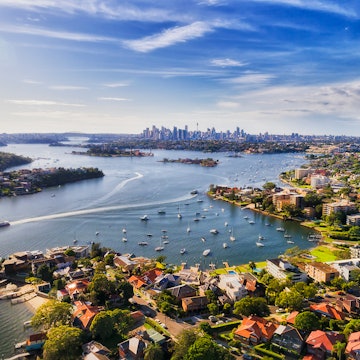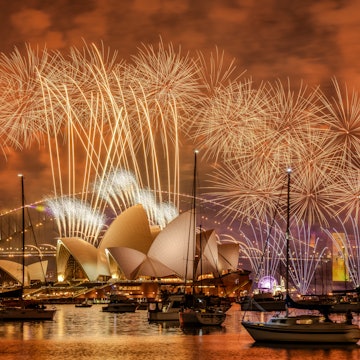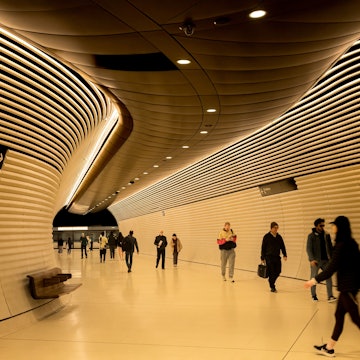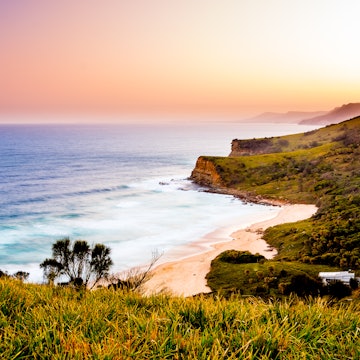

The northern hemisphere winter is Brisbane's blistering summer © Martin Valigursky / Shutterstock
Brisbane’s fantastic subtropical climate is one of its biggest claims to fame. The city enjoys around 280 days of sunshine each year, making Brisbane perfect for outdoor activities almost year-round. It never gets really cold – even in July, the city’s coldest month, daytime temperatures range from 51–73°F.
But it does get humid in this part of Queensland. At the height of the Australian summer, from December to February, Brissie can get uncomfortably sticky with average temperatures of 85°F and 65% humidity. Plus, big thunderstorms sometimes roll in at the end of the day. If you're coming from the northern hemisphere winter, however, that's a small price to pay, and you can always cool off on the Gold Coast or at Brisbane's city beach.
That said, it shouldn't be entirely surprising that the busy season in Brisbane is during the cooler and drier months. This is when most big events are scheduled and it’s the most comfortable time to be in town, and still warm enough to swim and enjoy the sun.
The main thing to watch when choosing a time to visit is the Australian school calendar. In Brisbane, like the rest of Queensland, school holidays bring a huge increase in visitor numbers as families flock to the sunshine state with the kids. Here's a guide to the best times to visit Queensland's first city.
Brisbane’s seasons: an overview
Brisbane has four distinctive seasons:
Spring runs from September to November and sees average temperatures of 59°F to 77°F. The humidity is much more tolerable during this time.
Summer starts in December and finishes in February. The daytime heat averages 86°F, but the sudden storms and humidity make it a hot and sticky season.
Autumn (Fall) is from March to May, and temperatures and humidity start to become a more pleasant 59°F to 77°F. This is a great time to avoid the crowds.
Winter averages 50°F to 68°F and runs from June to August. For those who aren’t fans of heat and humidity, this is the best time to take advantage of all Brisbane has to offer.
High season: May–September & January
Best time to visit for sunshine and festivals
The Australian winter from June to August is the peak season for Brisbane, when the sun shines reliably and there’s very little rain. The high season includes the surrounding months due to the favorable weather. The best festivals are held at this balmy time of year, especially in May and September. Temperatures are warm but not overpowering, rising to around 79°F and rarely dipping below 11°C (51°F). You’ll still be in your T-shirt and flip-flops by day, but you’ll need long sleeves for the evening.
This season is when Australia's southerners, shivering in their offices in Melbourne and Sydney, take quick, impulsive weekend trips to Queensland to defrost. During the school holidays (which are staggered over different states in June/July and across September) you’ll need to book well in advance to secure accommodation and domestic flights.
In January, a swelteringly hot and humid month, traveling to Brisbane is still a high season thanks to the Australian school summer holidays. Temperatures can reach 113°F, with regular days of heavy rain, but the city is still packed with holidaying families. Book well ahead for accommodation, activities and transport.
Shoulder season: March–April & October
Best time to visit for good weather and smaller crowds
The Australian spring (September–November) and fall (March–May) shoulder seasons are good times to visit Brisbane. At the end of March, the uncomfortably hot and humid summer conditions finally ease and temperatures drop to a more manageable 59-77°F. Humidity eases up too and accommodation and travel prices fall from their winter peak (except during the Easter school holidays).
From October, the mild days become increasingly warm; sunny days are cooled by sea breezes but the big rains haven’t yet arrived. October is also a great month for festivals – all of Brisbane seems to be hitting the town in search of a party.
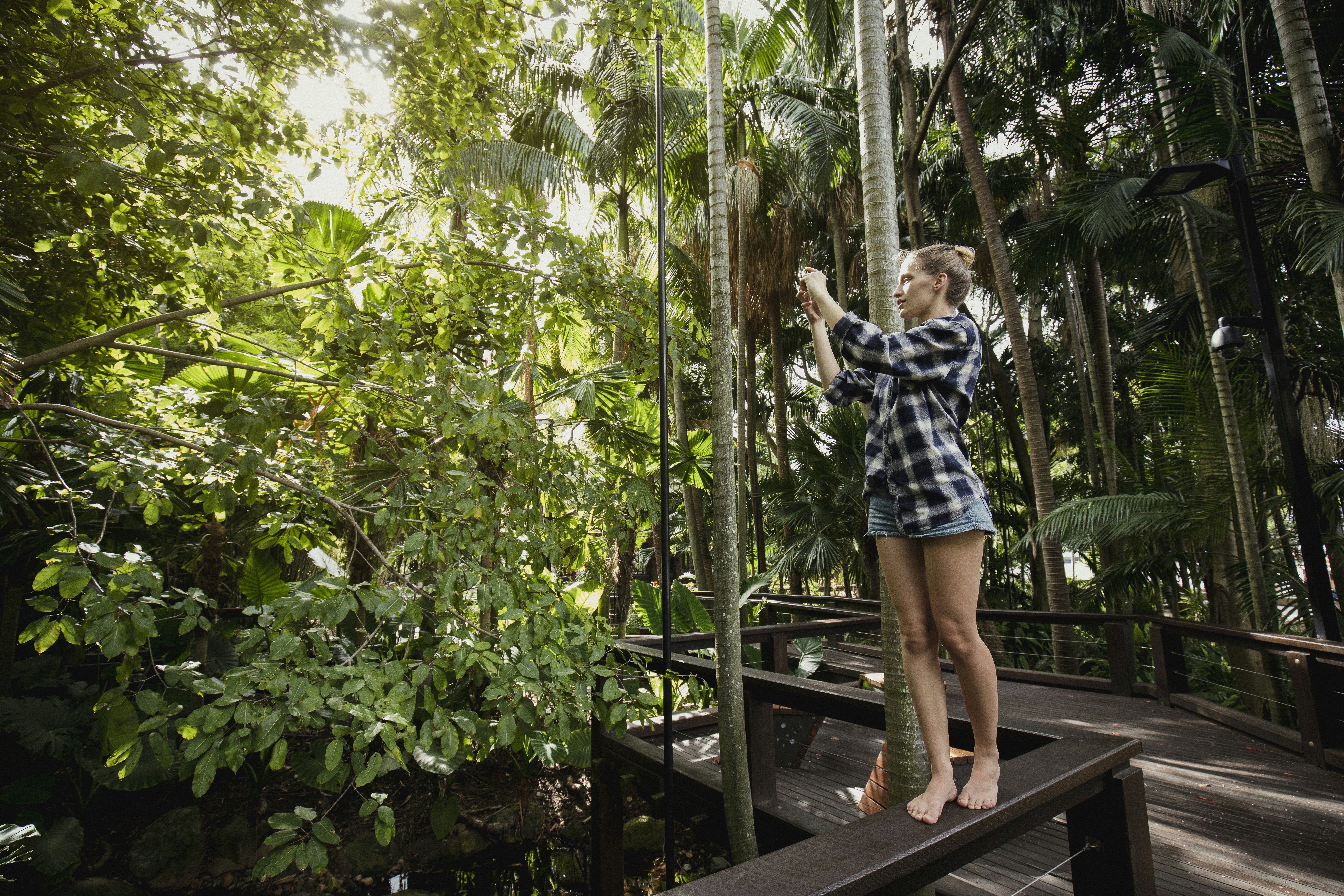
Low season: November–December & February
Best time to visit for budget travel
Summer in Australia runs from December to February. Still, Brisbane in November is equally as hot and is part of the low season in Brisbane, except the January school holidays, when prices are at a premium. There's a reason for this: in summer, the city is hot and sweaty and often drenched in downpours as this is Brisbane’s rainy season. February, the wettest month, frequently sees heavy storms. This is the rainiest month, with average temperatures hovering between 72°F and 86°F and can claim higher. Plus, monthly rainfall can be triple the winter average.
But this is a great time to snag an accommodation bargain and see Australia on a budget. The arrival of dramatic thunderstorms can actually be a drawcard if you like elemental forces. It’s also peak surf season in South-East Queensland, and every third year the Asia-Pacific Triennial of Contemporary Art, organized by the Queensland Art Gallery, hits town over the summer.
Visiting Brisbane: a month-by-month guide
Here's a guide to the best times to visit and what you can expect throughout the year in Brisbane. All events are subject to change.
January
Hello school holidays. Australian schools all have summer holidays running from mid-December to the end of January. All of Australia’s school children seem to be packed into the state of Queensland in January despite the uncomfortably hot and sticky weather, which ranges from 73°F to 88°F. Crowds and accommodation prices soar, especially at theme parks like Warner Bros. Movie World, Sea World and the new Bluey’s World, plus other kid-friendly attractions. While the lines won’t be as bad as US-based theme parks, the crowds plus the heat can make for a tiring day.
Key events: Brisbane International
February
With the kids tucked back into their school uniforms, Queensland can breathe out. However, temperatures are at their highest ranging between 73°F to 88°F and humidity reaches its peak in February, at 65-70%. You may get slight relief from the heat during one of the common afternoon thunderstorms at this time. Now would be a great time to consider Brisbane’s indoor activities, such as the Opal Museum. An air-conditioned bus tour to one of the many breweries is also a great option.
Key events: BrisAsia Festival, Queensland Cabaret Festival
March
Slowly, the heat and humidity in Brisbane begin to subside toward the end of March, making it a more comfortable time to explore the city's many attractions. The slightly cooler weather is perfect for outdoor activities like strolling through the lush Botanic Gardens, kayaking on the Brisbane River or enjoying a picnic in South Bank Parklands. It's also a great time for budget-savvy travelers, with excellent deals on accommodation and fewer crowds.
Key events: Weird Science Festival Brisbane
April
Despite the drop in temperature, April is Brisbane’s sunniest month due to the lack of rain. Temperatures fall between 64°F to 81°F, making it a good time to visit, with Brisbaneites slowly emerging from their air-conditioned hibernation. It’s perfect weather to enjoy activities on the Brisbane River, such as picnics or river cruises. Avoid the visitor spike over Easter (school holidays usually run for two weeks and include the Easter weekend), but otherwise, make the most of the sunny weather for beach trips and activities.
Key events: Oceania Cycling Championships

May
May is one of the best times to visit Brisbane, as it marks the beginning of the city’s most pleasant weather. Daytime temperatures average between 59°F and 77°F, making it ideal for outdoor exploration without the intense heat or humidity. May also kicks off Brisbane’s festival season, featuring events like the Brisbane Street Art Festival, which showcases larger-than-life murals in unexpected spaces, and Paniyiri, the city’s iconic Greek festival. It's a great time to be in town.
Key events: State of Origin, Brisbane Comedy Festival, Paniyiri, Brisbane Street Art Festival, MELT Festival of Queer Arts & Culture, Brisbane Gin Festival, Brisbane Writers Festival
June
Humpback whales begin migrating off the coast in May, a spectacle that lasts until October. Whale-watching tours from nearby spots like Moreton Bay, Moreton Island, or the Sunshine Coast provide an unforgettable opportunity to see these magnificent creatures up close. With cooler weather averaging between 50°F and 70°F, it's an ideal time for outdoor activities like hiking in the scenic hinterland or browsing local markets. To save money, avoid the June/July school holidays when prices tend to spike.
Key events: State of Origin, Brisbane Marathon, Out of the Box Festival
July
Brisbane’s coldest month rarely drops below 52°F even at night, while daytime temperatures hover around a pleasant 70°F. The crisp, clear mornings make it a perfect time for outdoor activities. While you won’t need a heavy coat, it’s a good idea to pack a sweater for the cooler evenings, especially if you’re out enjoying live music at events like the Anywhere Festival. While you might not be familiar with Australia’s sporting traditions, tickets to the State of Origin rugby matches will get you into the Aussie spirit.
Key events: State of Origin, Anywhere Festival
August
August is an ideal time to visit Brisbane, with sunny days and an average temperature of 72°F, perfect for exploring the city’s outdoor attractions like South Bank Parklands or Mount Coot-tha. This month, the Royal Queensland Show, known as Ekka by the locals, is a highlight that features agricultural exhibits, carnival rides, live entertainment and show bags filled with treats. August is also great for river cruises or enjoying Brisbane’s varied dining scene, with many alfresco options.
Key events: The Ekka, Bridge to Brisbane

September
In addition to May, September is one of the best months to visit Brisbane. With warm days, cool nights and fantastic weather perfect for outdoor activities, the month also features premium events that coincide with the school holidays, making it a busy time. The Brisbane Festival is a major highlight, attracting large crowds, especially for the spectacular finale, the Riverfire fireworks. Be sure to book accommodation and tickets well in advance.
Key events: Brisbane Festival, NRL Grand Final, Bigsound Festival, Brisbane Pride Festival
October
Festival-packed October marks the middle of fall in Australia, with daytime temperatures averaging between 59°F and 81°F as the city starts to warm up. This is also a perfect time to see jacarandas in full bloom, transforming Brisbane with vibrant lilac hues. These striking trees line many streets and parks, offering stunning photo opportunities. Visit the City Botanic Gardens or New Farm Park, where walkways beneath the flowering trees feel almost otherworldly and perfect for a stroll.
Key events: Valley Fiesta, Brisbane International Film Festival, Brisbane Portrait Prize
November
The heat increases at the start of Brisbane’s low season, with daytime temperatures averaging between 73°F and 86°F. Spectacular thunderstorms start to crack over the city, bringing bursts of rain and rising humidity. The wet season typically runs from November to March, so expect showers and steamy days. If you can handle tropical humidity and some rain, this is an excellent time for budget travelers to visit, as accommodation rates are lower and fewer tourists are around.
Key events: Wynnum Fringe, Brisbane Shakespeare Festival
December
December in Brisbane marks the start of the summer solstice and the festive Christmas season, with long days and rising temperatures. Average daytime temperatures range from 73°F to 88°F, and the heat is accompanied by increasing humidity. Thunderstorms become more frequent and intense, especially later in the month. As school holidays begin, the city sees an influx of visitors from southern states, drawn by Queensland's outdoor lifestyle and warm weather. This is a popular time for outdoor festivals, Christmas markets, and beach trips.
Key events: Moonlight Cinema, Wildlands
You may also like:
Things to know before traveling to Australia
5 unmissable Scenic Rim hikes: ancient rainforests and lush waterfalls await you
Queensland by sea: Vivid experiences on and under the water
Queensland by land: Lush forests, open beaches and fascinating culture










